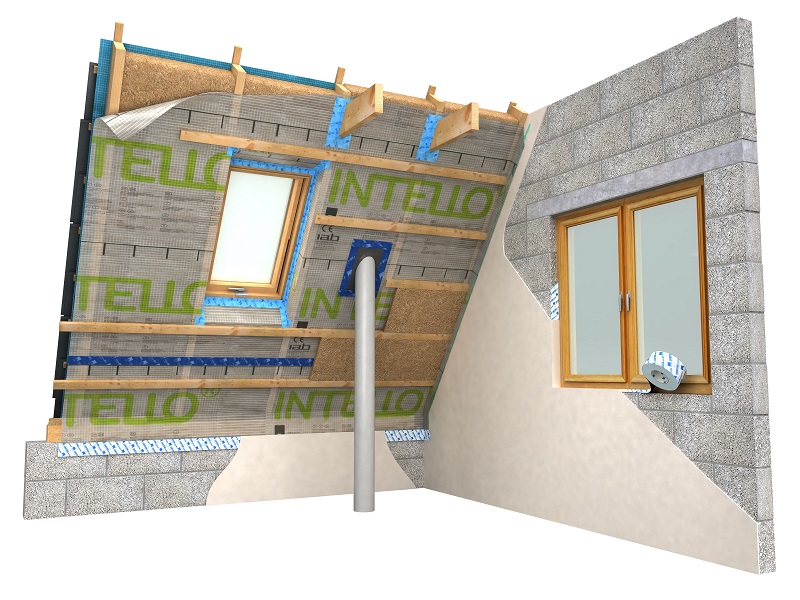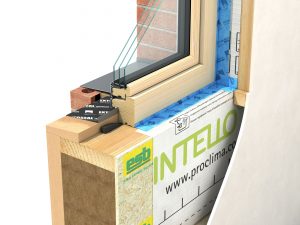
Fintan Wallace from Ecological Building Systems discusses the benefits of addressing airtightness and thermal bridging with natural insulation as part of social housing upgrades.
One of the huge challenges facing social housing providers is reducing fuel poverty amongst tenants, particularly in thermally-inefficient, older properties. Much has been done to improve energy efficiency across the social housing asset base, including the introduction of renewable energy sources such as solar panels to reduce the amount of energy taken from the grid, the introduction of energy-efficient boilers and HIU (heat interface units) for multi-occupancy properties and lower tariff heating systems, such as Economy 7. However, whilst these are valid approaches to driving down energy consumption, they cannot deliver their full potential benefits if they are installed in isolation.
Instead, such energy saving measures should be combined with a fabric first approach to improving properties’ thermal performance to deliver a refurbishment strategy that retains the heat in winter and resists solar gain in summer for an ambient, comfortable indoor environment all year round.
Performance Gaps
Natural insulation materials, such as wood fibre and jute, provide an opportunity for improving a home’s thermal performance through external or internal installation retrofit on roof or wall surfaces. With systems designed specifically for refurbishment projects, they offer a breathable solution that allows moisture to escape while trapping warm air, preventing any humidity- or condensation-related damage to the existing structure.
Many legacy social housing homes have already been upgraded in recent years to answer Decent Homes requirements and bring them up to current Part L building regulations — but not all of these are performing to their designed thermal performance standards. This is because the thermal properties of the insulation material itself are only part of the picture when it comes to ensuring the installed performance of the system in situ.
Specification of insulation is based on the thermal conductivity of the material, which is expressed as a Lambda value. The lower the conductivity of the material, in theory, the less warm air will escape. Consequently, the specification of social housing refurbishment projects will usually focus on selection of an insulation material with very low thermal conductivity — typically PIR board — as a thinner profile will be required to reduce heat loss through the wall or roof area.
 The problem with specification based solely on the thermal properties of the insulation material used is two-fold. Firstly, not all of the building envelope can be encapsulated with the insulation material because of the need for windows and doors. Increased thermal conductivity in these areas can cause thermal bridging which could, potentially, compromise the calculated thermal performance of the installed insulation system.
The problem with specification based solely on the thermal properties of the insulation material used is two-fold. Firstly, not all of the building envelope can be encapsulated with the insulation material because of the need for windows and doors. Increased thermal conductivity in these areas can cause thermal bridging which could, potentially, compromise the calculated thermal performance of the installed insulation system.
Secondly, even a small gap — as little as 1mm — between insulation panels can dramatically alter the thermal performance of the whole installation due to air loss. If the building is not airtight, warm air can escape regardless of the thermal properties of the insulation, which means that the building’s thermal performance in practice could be significantly lower than the designed U-value at specification.
Natural Benefits
While natural insulation products have historically been seen as a niche, eco product, the benefits they offer make them an ideal solution for social housing. Not only do they exploit the materials’ natural properties to offer both excellent Lambda values and breathability, but they are free from chemical components and provide excellent building comfort, contributing to healthier buildings at lower risk of common problems such as damp, mould and condensation.
Made by processing timber offcuts grown in sustainable forests, wood fibre systems like Gutex can be fabricated with tongue and groove edges to facilitate a gap free installation, ensuring excellent airtightness is achieved to aid U-value performance.
Meanwhile, natural jute insulation, like Thermo Jute 100, is manufactured from recycled ‘gunny bags’ used to transport cocoa to Europe. The fibres contain no proteins, which prevents any possibility of mould growth or insect infestations and the insulation material is soft and flexible, enabling it to be use in a variety of locations, including between rafters, ceiling joists and floor joists and in partitions and stud walls. Indeed, wood fibre and natural jute can be used in combination on a property as the rigid wood and flexible jute have varying advantages for different areas of the build.
Goal-oriented
As energy prices and demand for social housing continue to increase, it is vital that the sector retains a clear focus on enhancing existing social housing accommodation to provide enhanced comfort and reduced bills for tenants along with an extended service life for providers. Refurbishment schemes that focus on improving the thermal performance of the building fabric with reduced air loss and thermal bridging is a critical way of achieving these goals and natural insulation could prove an important element of the solution.








